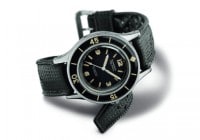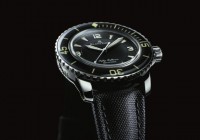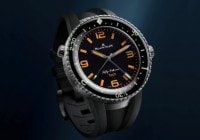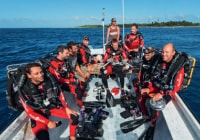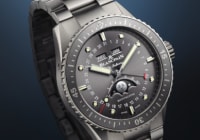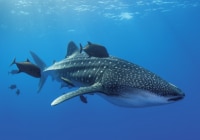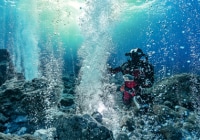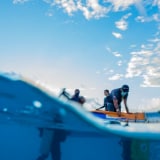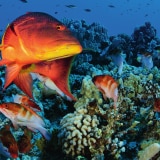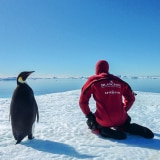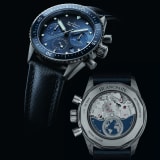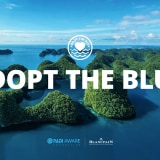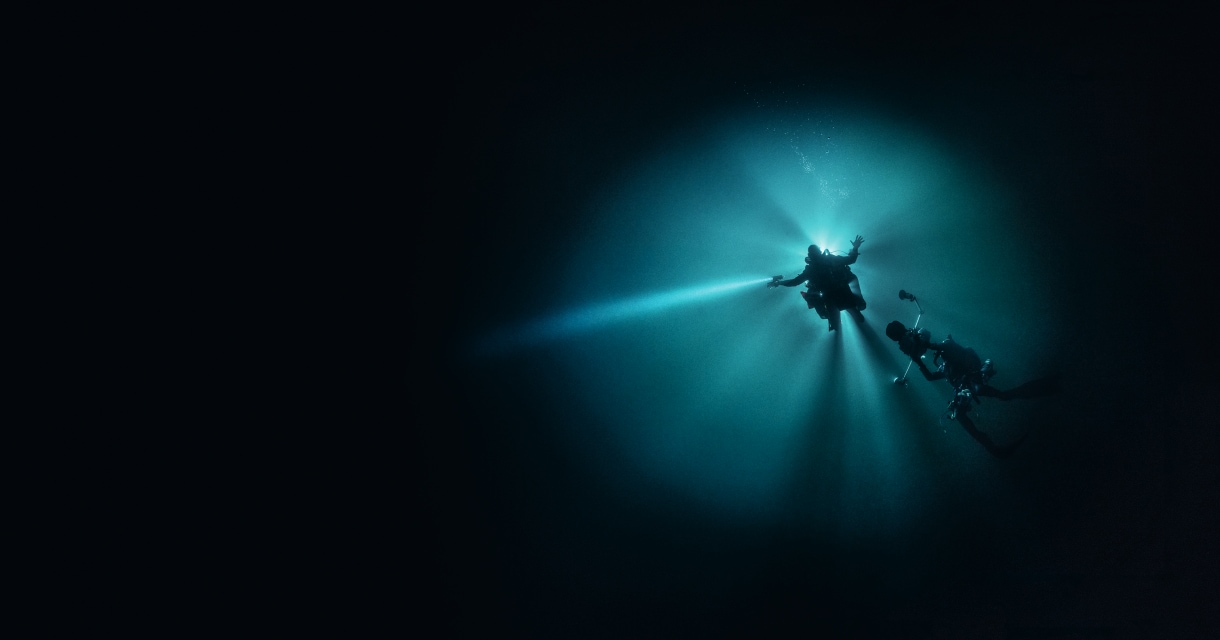
Search in Issues
Chapters
List of parts
Chapter 7
BLANCPAIN’S OCEAN COMMITMENT
A chronicle of Blancpain’s devotion to ocean preservation over the past two decades.

Blancpain has selected OCEAN PRESERVATION partners whose projects are consequential, and where Blancpain’s support CAN MAKE A DIFFERENCE.
It began with whale sharks. When Marc A. Hayek arrived to take the helm at Blancpain, he already not only had a deep love of the ocean—born of a childhood spent watching Cousteau films and a later desire to take up the sport of diving—, but also a particular fascination with sharks. While diving in Indonesia, he encountered whale sharks that were remarkable for their patterned markings, each as unique to the individual as fingerprints are to us. Along with his budding interest in the species came a conviction that divers such as himself marshalled together could become a vital force for preservation, not only in the places inhabited by sharks for extended periods, but also along the routes they follow between those locations.
His initial efforts brought him to PADI (Professional Association of Diving Instructors) in 2003. With PADI centers located around the world and thousands of divers receiving instruction and dive certifications in those centers, Hayek was an advocate for what was then a novel notion called “citizen science”, enlisting divers through PADI to study whale sharks by photographing them and noting the location of the photos. In this way, their habitats and migration patterns could be better understood and, once identified, measures to protect them could be put in place. Unfortunately, the citizen science idea was ahead of its time and the necessary organization was not yet sufficiently established. However, Blancpain’s research into the possibilities cemented an insight to guide the future: underwater photography as an important tool in ocean preservation campaigns. Hayek came to the realization that photography had a potential dual role: to gather scientific data and, also, to raise awareness among the general public of the need for environmental action.
Blancpain’s first step in marshalling the persuasive power of underwater photography was the creation of the Edition Fifty Fathoms in partnership with Dietmar Fuchs, a diver and editor of a variety of underwater-oriented publications. Released annually, the Edition Fifty Fathoms were heirloom-quality books featuring the works of world-renowned underwater photographers.
The 2007 launch of the new generation of the Fifty Fathoms not only signaled a rebirth of the Fifty Fathoms collection, but also rekindled Hayek’s desire to find a partner for consequential ocean projects and where Blancpain’s support could make a difference.
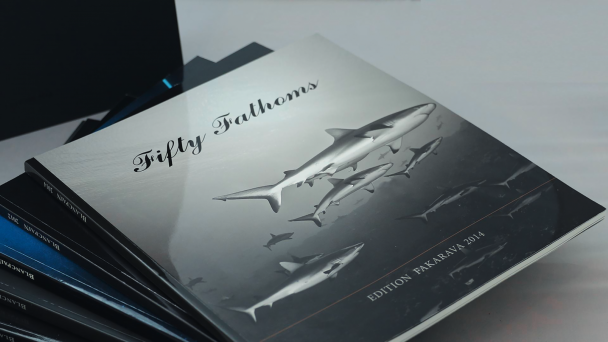
A first step, the creation of the Edition Fifty Fathoms.
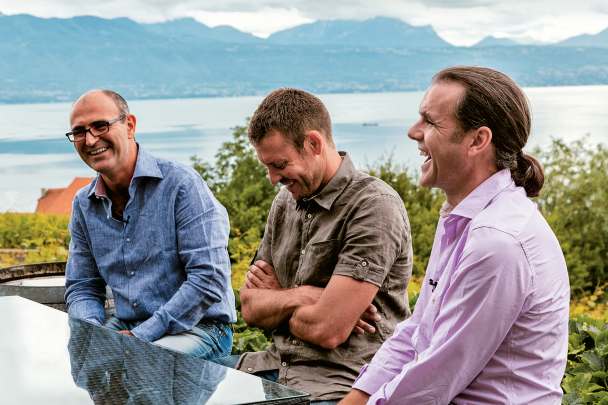
A moment shared on the shores of Lake Geneva. Marc A. Hayek with Laurent Ballesta and Enric Sala.
That opportunity came from a meeting with Dr. Enric Sala, who was the founder and leader of National Geographic’s Pristine Seas expeditions. Sala, in the search for funds to underwrite his project, had already approached and been turned down by many substantial business organizations. The ambitions for Pristine Seas were formidable: to study and photograph currently unspoiled areas of the ocean and thereafter, armed with photographs and studies demonstrating the beauty and importance of the ecosystem, to approach the relevant government officials to persuade them to enact environmental protection measures. As Hayek and Sala talked, one more dimension was identified. Asking political leaders to cease exploiting an ocean area was potentially costly, depriving enterprises and individuals of livelihoods dependent on fishing. Rather than merely telling leaders to issue decrees forbidding activity in the areas needing protection, Pristine Seas would present a more creative and innovative alternative. By establishing a protected nature preserve, termed a “Marine Protected Area”, where ocean wildlife could reproduce unmolested, those fishing businesses and individuals could have greater success focusing their efforts outside of the preserve. The protected breeding inside the preserve leading to a greater population outside. As an added plus, environmentally aware tourism within the preserve would become more attractive and successful. In short, through this approach, the people would have more not less by protecting the ocean resource. Hayek saw this Pristine Seas “business model” as key to achieving results from the expeditions.
Willing to take a risk where other businesses had balked, Blancpain agreed to become the founding partner of Pristine Seas and underwrite expeditions for five years, committing one million dollars per year to the project. The success of the Pristine Seas/Blancpain partnership was extraordinary. Of the 14 expeditions ultimately supported by Blancpain, 12 resulted in governmental preservation decrees, representing a doubling of environmentally protected ocean equal to a surface area of over 4.7 million square kilometers.
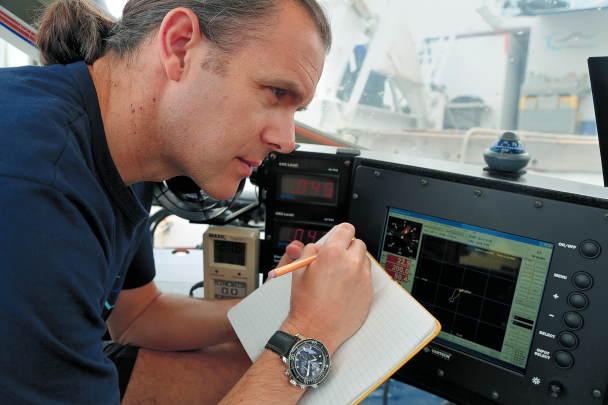
Dr. Enric Sala
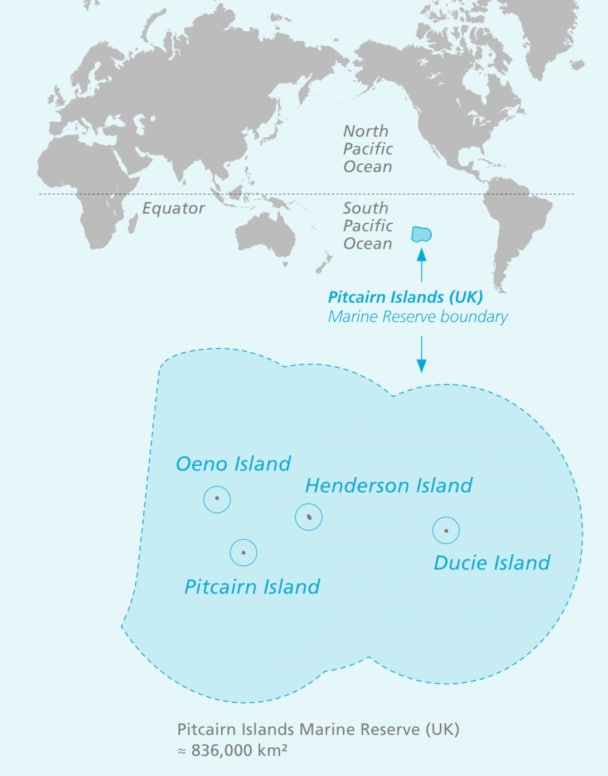
A graphic depiction of the Pitcairn Marine Reserve area resulting from the Pristine Seas expedition.
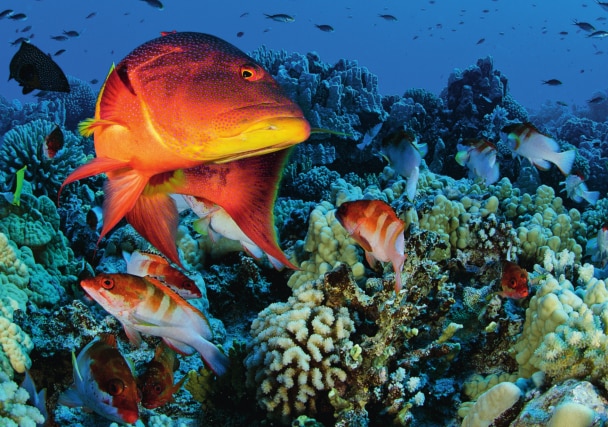
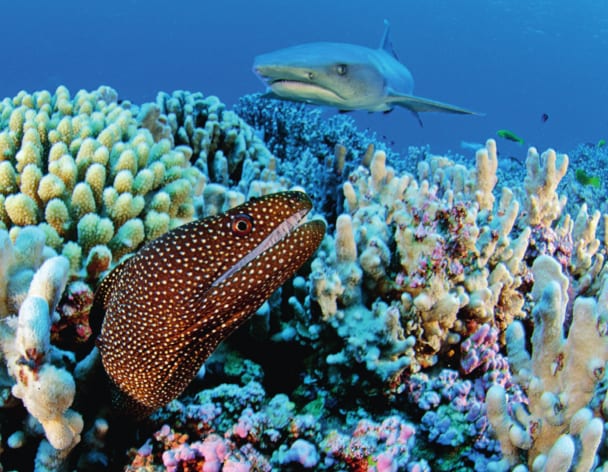
Photos from the Pitcairn Pristine Seas expedition.
A second important partnership arrived through serendipity. French diver, scientist, photographer, and environmentalist Laurent Ballesta visited the Basel fair in 2012 hoping to find a funding partner. To demonstrate some of his talents, he brought a portfolio of his underwater photography. By chance, Blancpain’s then Vice President Marketing, Alain Delamuraz, encountered Ballesta in one of the booths, saw his impressive work, and immediately took him in tow to introduce Marc A. Hayek. Hayek’s agenda that day was overflowing with back-to-back meetings with nary a short interlude. Nonetheless, the two sat down to talk with apologies in advance that the time available would be frightfully brief. After just a few minutes, the remainder of Hayek’s schedule was postponed. As the two shared their passions for the ocean, Ballesta put forward his dream. He had previously completed a deep-water dive in African waters and spotted what he believed to be a Coelacanth, a prehistoric fish long thought to have become extinct centuries ago. The Coelacanth has been understood to be a precursor to the emergence of marine animals adapted for life on land. Excited by the sighting, he wanted to organize a world-first expedition to study and photograph it. Little was known about its habitat, its numbers, its evolution, its patterns of movement, or its relationship to other species. He proposed to observe the Coelacanth closely, gather its DNA, tag individuals, survey its habitat, and record it all on film. A tall order, as the depths of the grottos in which the Coelacanth lived were extreme, making the dives extraordinarily demanding. Even though Ballesta was known as a photographer, he was otherwise without backing and had never conducted expeditions of this ambition and magnitude before. Thus, there would be substantial risks for any potential financial supporter. Hayek followed his instincts, grasping immediately Ballesta’s talents and dedication. The result: Blancpain agreed to fund Ballesta’s Coelacanth expedition, which he had named “Gombessa”, the local Mozambique name for the Coelacanth.
Blancpain’s relationship with Ballesta has blossomed into many subsequent expeditions, all bearing the Gombessa name. His scientific research has been groundbreaking and truly important. More impactful for the general public have been his photographs and films, which have been seen by millions. Indeed, Ballesta received the prestigious Wildlife Photographer of the Year award for his work—an accolade that was later followed by two additional Wildlife Photographer of the Year honors, as well as several other film awards. There are those who champion environmental causes by showing the horror of destruction. Ballesta and Hayek believe the opposite; theirs is a positive message. It is more powerful and inspirational to let people discover the wonder and beauty of the ocean and, from that, find the motivation to act.
As Blancpain’s ocean-oriented environmental campaigns grew in scope and importance, Blancpain sought to embrace what were individual initiatives under a larger whole. The umbrella name for its ocean preservation efforts came to be known as the “Blancpain Ocean Commitment”. Not only did the Ocean Commitment signal Blancpain’s devotion to the cause, Blancpain enlisted dedicated personnel whose sole job function would be to oversee management of the relationships with partners, such as Pristine Seas and Ballesta, and to identify other worthy partners.
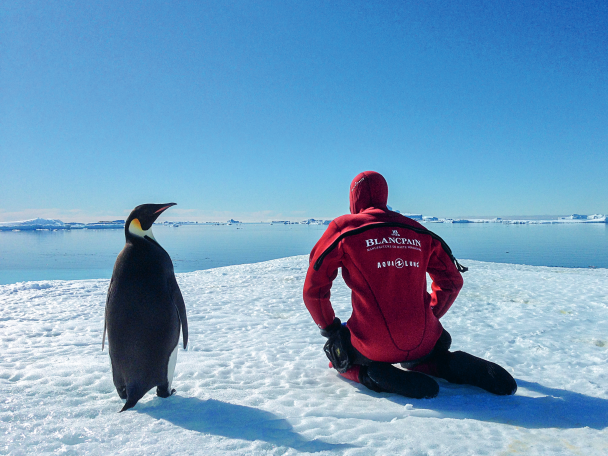
Laurent Ballesta during the Gombessa 3 expedition to Antarctica.
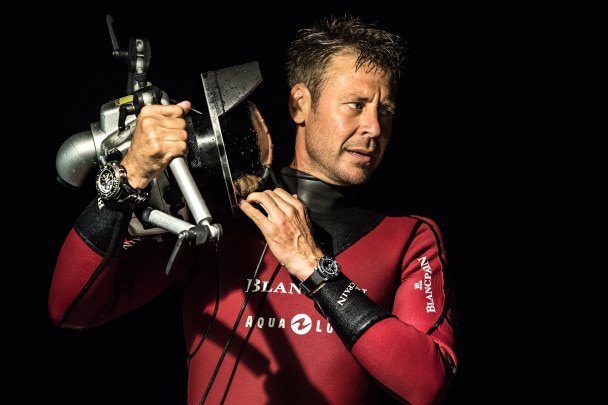
Laurent Ballesta
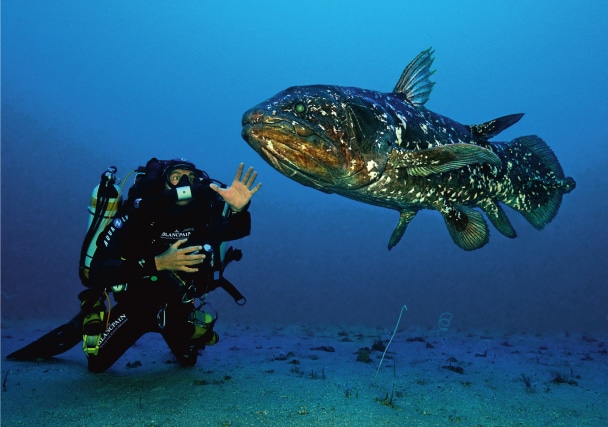
The Coelacanth, Gombessa 1.
As Blancpain’s ocean preservation efforts GREW in scope and importance, Blancpain brought them under a single umbrella name: the BLANCPAIN OCEAN COMMITMENT.
The creation of the Ocean Commitment spawned the release of three limited-edition series (250 timepieces each) of special Ocean Commitment watches from the Fifty Fathoms collection. In order to give the purchasers a sense of their own personal participation in supporting ocean environmental efforts, Blancpain dedicated the sum of 1,000 dollars for each piece—a total of 250,000 dollars for each series—as a donation to programs such as Gombessa.These donations were funds in addition to the significantly larger financial backing that Blancpain was already providing.
Over the course of the Pristine Seas and Gombessa projects, Blancpain demonstrated confidence in its vision and willingness to take on risk with its donations. The Ocean Commitment team has remained on the lookout for new initiatives and, thanks to its profile from past years as a generous donor, they are now receiving dozens of applications each year from project organizers seeking funding. Successes on many fronts have followed. No less thanthe United Nations has become a forum for the Ocean Commitment initiative. The UN sought to promote its World Ocean Day with a photographic exhibit. Their thinking was much like that of Blancpain. Exposing the public to the wonder of marine life is a powerful motivator in aid of preservation. However, the UN lacked both financial resources and, for that matter, photos. Introduced by Dietmar Fuchs, Blancpain funded the first large-scale exhibition of underwater photography to take place within the United Nations building in New York. Thousands of visitors and diplomats from around the world were treated to the extraordinary works of Laurent Ballesta, Enric Sala, and many of the photographers featured in Edition Fifty Fathoms at that first exhibition.
Another initiative has been Blancpain’s role as the founding partner of The Economist newspaper’s yearly World Ocean Summits. These conferences are a gathering of scientists, government officials, business leaders, journalists, and concerned citizens who are dedicated to ocean protection and preservation. In addition to the Summit conferences, Blancpain has supported special ocean preservation films, entitled “The Protectors” series, produced by The Economist.
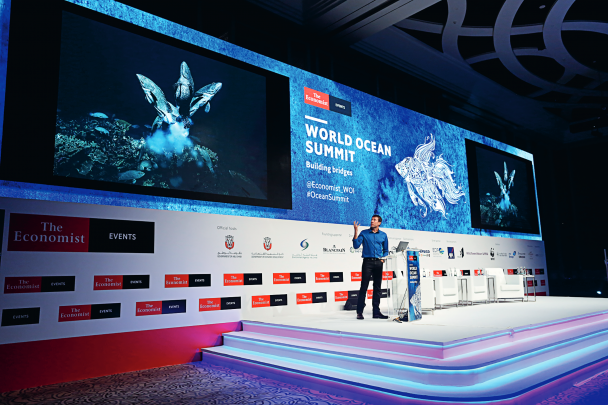
Laurent Ballesta speaking at a World Ocean Summit conference.
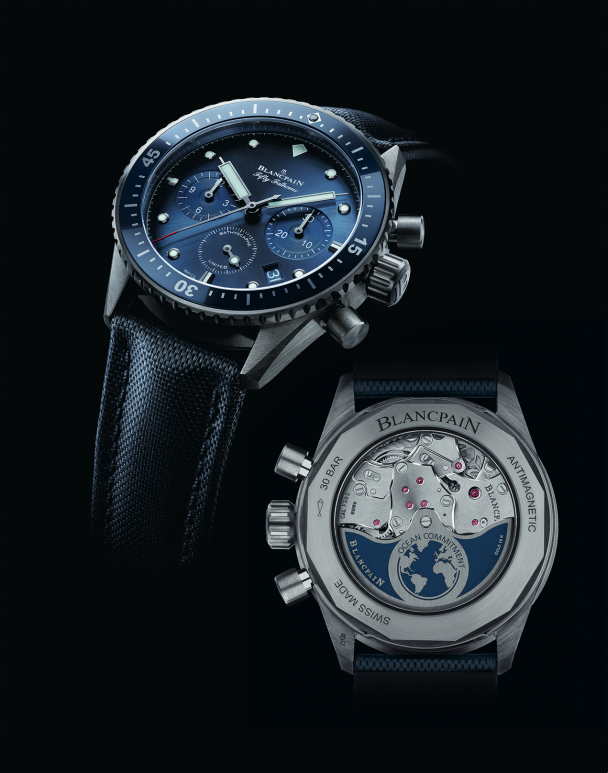
The first Ocean Commitment limited edition, the Bathyscaphe Chronographe Flyback, in ceramic.
Sharks remain a focus of BLANCPAIN’S preservation efforts. It is a founder and financial supporter of the MOKARRAN PROTECTION SOCIETY.
Sharks remain one area of focus for Blancpain and Hayek. A leading organization in the campaign to protect sharks in French Polynesia is the Mokarran Protection Society (“MPS”), which Blancpain helped found and for which Blancpain has provided extensive funding. The focus of the MPS has been the Sphyrna mokarran, commonly called the “great hammerhead shark”. These are large, formidable-looking animals. Anomalously, despite their appearance and size, hammerheads are in fact fearful and are, indeed, quite fragile. Significant numbers of great hammerheads have been observed in two areas of French Polynesia: first, the famous Tiputa Pass, which is a deep channel separating segments of the Rangiroa atoll (featured in our wine article on pp. 150-165 of this Issue) that connects the open ocean on one side with the large Rangiroa lagoon on the other and, second, the lagoon near the closely located atoll of Tikehau. Marine biologists seek to unravel many mysteries surrounding the lives of these great hammerheads. What are the characteristics of the S. mokarran? Do they differ from other known populations? When, where, and how do they feed? What are the targeted preys of its diet? What is its home range? Do they reach beyond the sanctuary in French Polynesia? Where, when, and how do they reproduce? What are the key areas for their nurseries? What are the pressures and threats that affect each phase of their life-cycles? Seeking answers to these questions will be extraordinarily challenging. To begin with, methods used elsewhere for shark study, attracting them with either bait or scents of bait and thereupon confining them, cannot be used. Artificial means of attraction risk distorting their food habits and confining, albeit briefly, generates stress that can be fatal. Therefore, the study group—calling itself the Tamataroa project and consisting of MPS together with Laurent Ballesta’s Gombessa team, all with the support of Blancpain— is planning an unprecedented ethical method of study. Searching for the sharks without luring, conducting measurements and tagging without confinement. Instead, the Tamataroa project plans on using a specially developed crossbow to collect biopsy samples and to insert miniature GPS-enabled tracking tags. In addition, in order to take size measurements, the divers will employ a laser photogrammetry system. The diving itself, which includes Hayek as a member of the team, will be particularly difficult, especially in the Tiputa Pass owing to its strong currents and the depths at which the hammerheads are found.
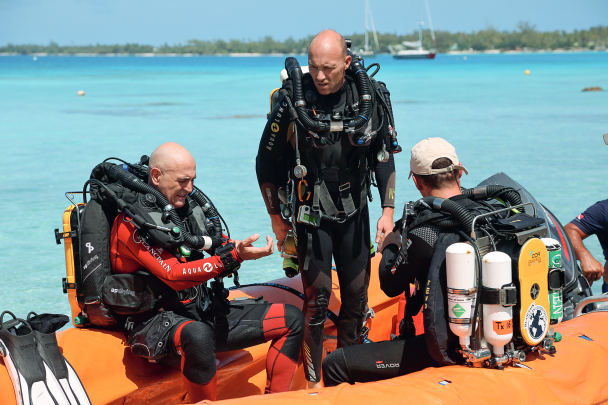
Marc A. Hayek during a Mokarran expedition in French Polynesia.
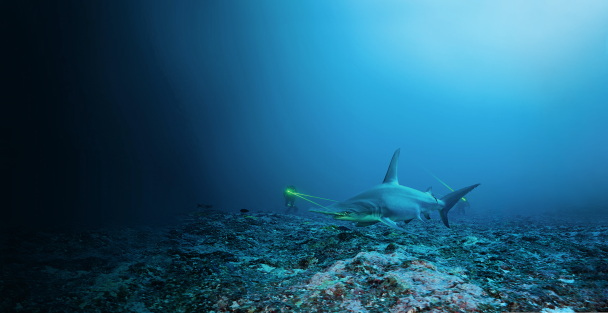
Using lasers to measure the size of a hammerhead shark.
Blancpain’s Ocean Commitment is EVER-EVOLVING as new dangers and partners present themselves.
The business model that Pristine Seas and Blancpain used so successfully in the past has now been re-employed in the Philippines. One of the islands in Shark Fin Bay was essentially devastated by dynamite fishing in the past. This disastrous and wasteful method employs explosives detonated in the water to kill fish in the area so that they can be amassed with nets. In a short period of time, virtually all marine life is extinguished. Today, the area around the island has been restored, with life now returning but remaining under threat from fishermen working in neighboring areas. Blancpain has partnered with the Sulubaaï Foundation to educate and persuade local villagers to adopt new methods of interacting with their environment. As was the case with Pristine Seas, this involves training them in innovative ways to restore the surrounding area and demonstrating that by creating preserves that allow marine life to reproduce unmolested, fishing outside of those areas by conventional methods can be more productive. Environmental protection delivering more, not less.
Events have now come full circle to where they began. When in 2003, Hayek had discussions with PADI about the citizen science idea, it was not then practical to proceed. After two decades, things have evolved. PADI has now grown its network to include 6,600 dive clubs worldwide. It has launched a multi-year, multimillion dollar initiative named “Adopt the Blue”. Adopt the Blue plans on “adopting” 1,000 environmentally important sites in the first year, with many more thereafter.
“Adopting” the sites means that divers will commit over time to providing information in the form of photographs and ocean data, such as water temperatures, salinity, and more from those sites. In addition, divers, including groups and clubs, will be supported in their efforts to create new Marine Protected Areas. Coincident with the enlistment of these citizen volunteer scientists is the creation of a digital platform for the gathered data. Blancpain is the strategic partner of PADI’s Blueprint for Ocean Action and a founding partner of Adopt the Blue and its dedicated platform. A sidelight. The citizen scientists have also been encouraged to become keen observers, including surveillance of any fishing vessels that wrongfully enter areas legally protected from fishing.
Blancpain’s Ocean Commitment is certainly not static. To the contrary, it is ever-evolving as new environmental dangers and partners present themselves. There is one constant: Blancpain’s determination to make a difference.
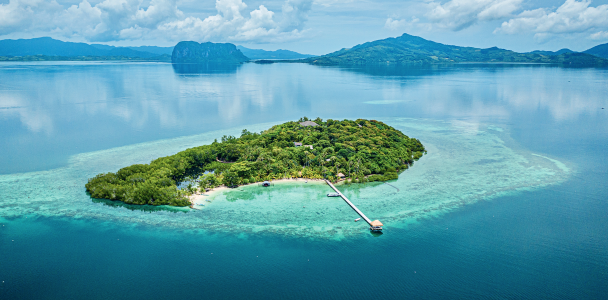
An aerial view of Pangatalan Island, Shark Fin Bay.

The villagers vote to approve the marine protected areas surrounding their village.
Other issues
Don't miss the latest issue
Sign Up for New Releases

